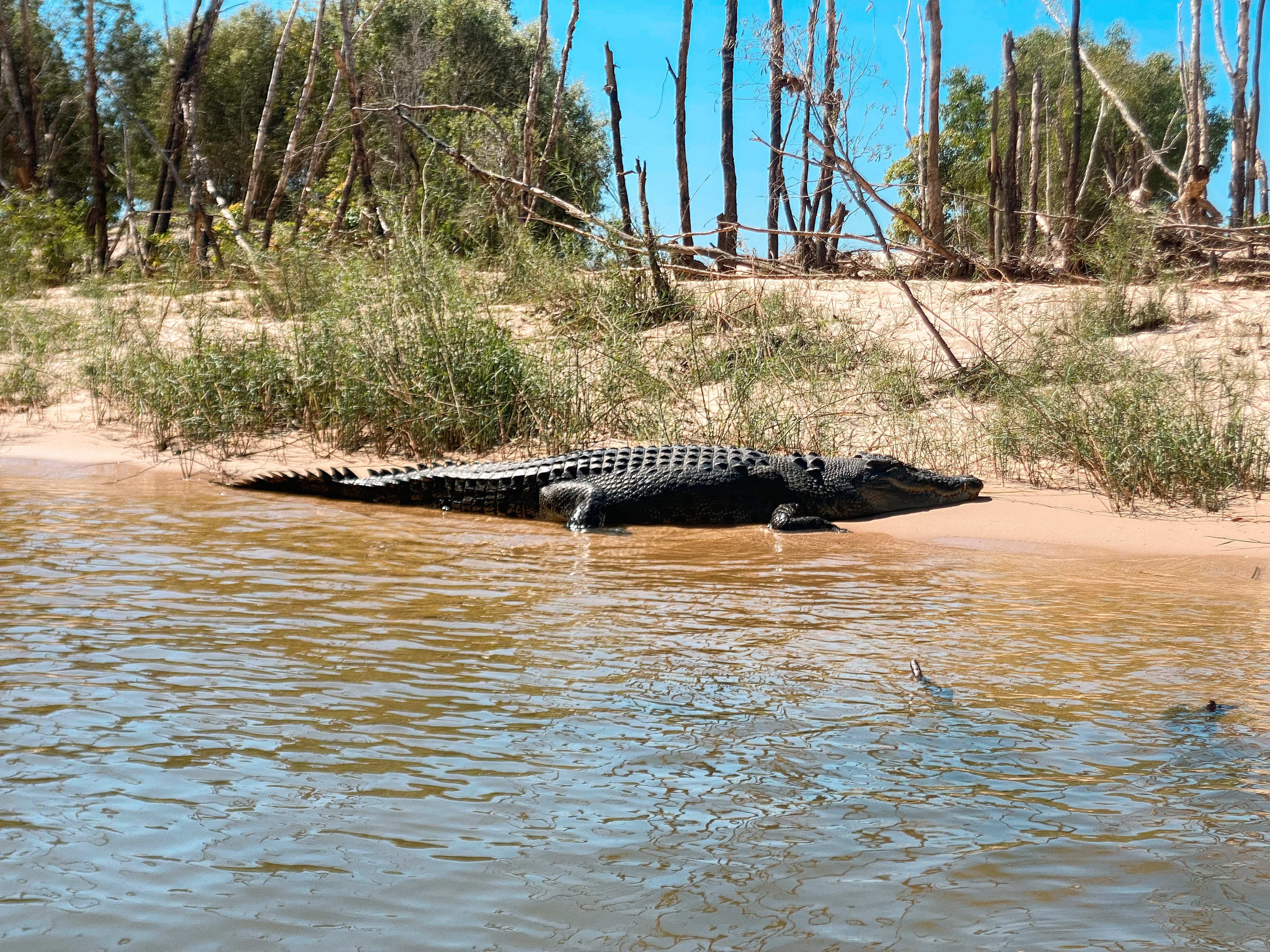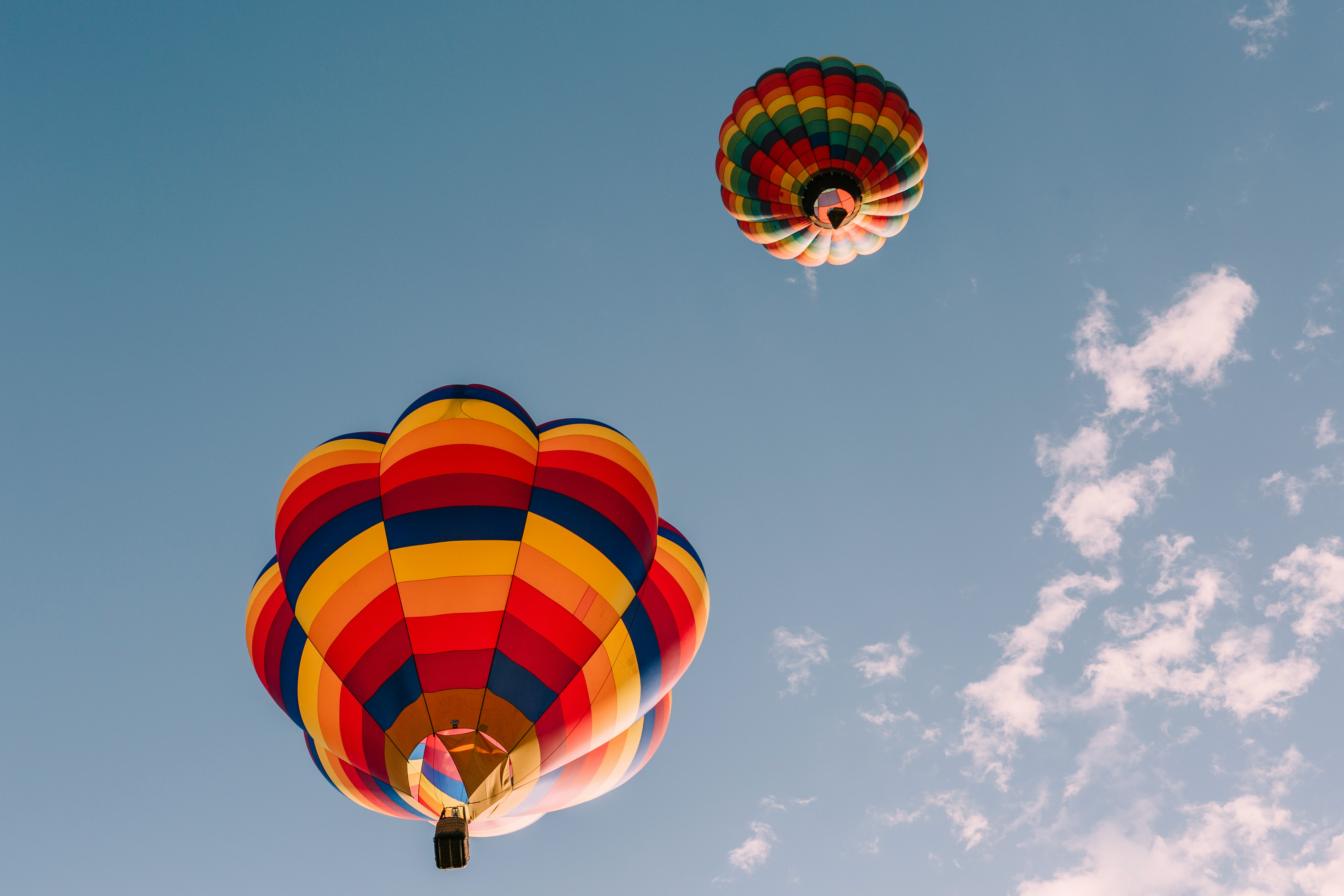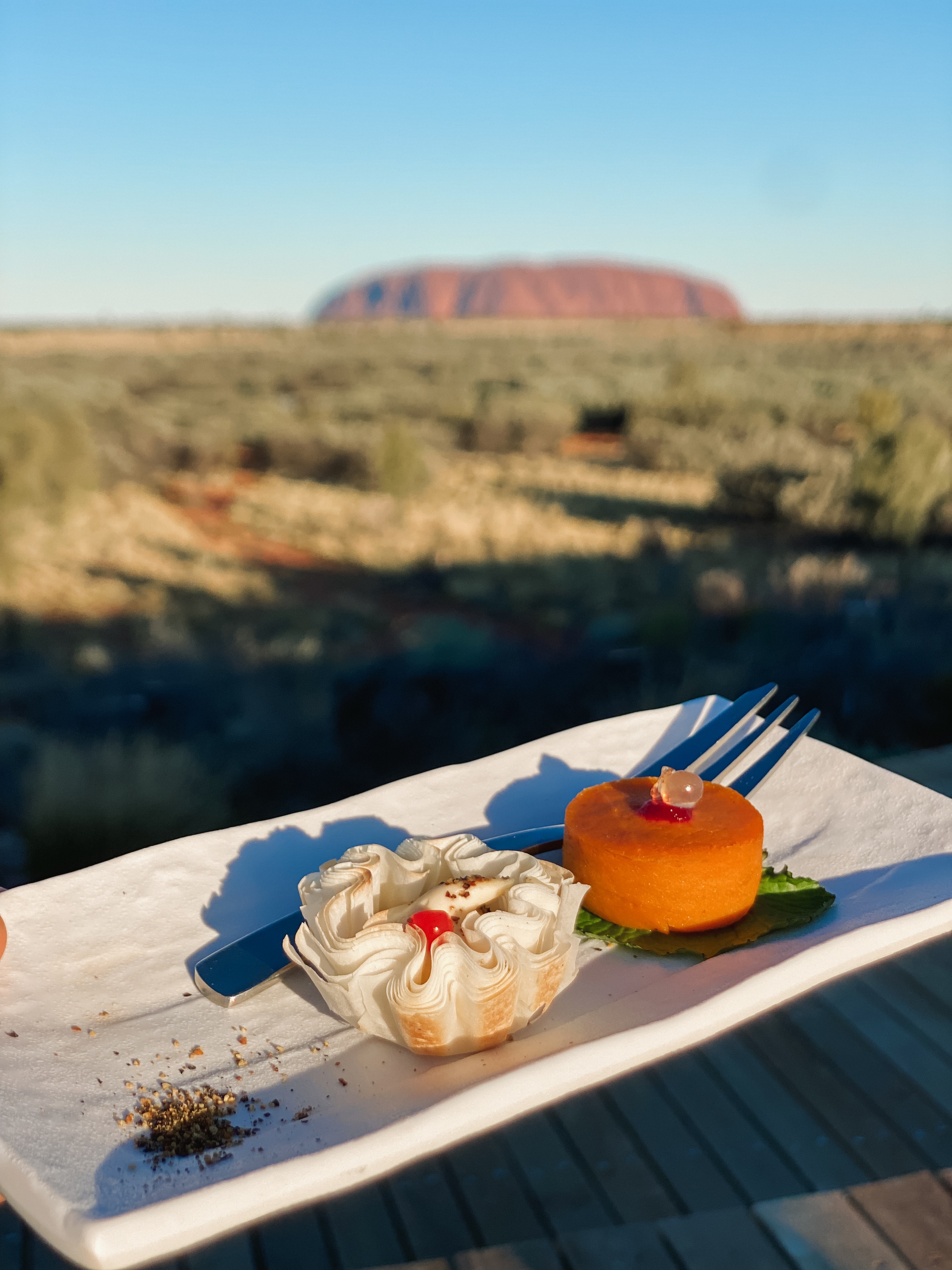In start contrast to Sydney’s skyline and Melbourne’s trendy streets, the Northern Territory promises something different: a chance to truly disconnect – to get off-grid and in nature. Refresh yourself in ancient watering holes, witness turtles nesting on island shores at twilight, and road-trip across the Australian Outback to take in the majesty of Uluṟu.
But this isn’t just about ticking off adventures or channeling your inner Steve Irwin (RIP 4 EVA). Visit the Northern Territory to witness Aboriginal culture embedded in rock paintings, desert landscapes, and the very land itself. This is real, raw travel at its best and most worldview-expanding. And it’s absolutely worth the journey — no matter how much bug spray you have to pack.
This guide chronicles my 11-day journey across the Northern Territory and will help you plan your own trip to Australia’s heart.
PART I — ARRIVING IN THE TOP END

After a 15-hour direct flight from LAX to Brisbane, I caught a connection to Darwin, the tropical capital of the Top End – the rugged northern region of the Northern Territory that’s closer to Bali than to most other major Australian cities.
What struck me first (besides the endless wetlands from the plane) was the size of the vehicles in Darwin. Colossal 4x4s, loaded with enough gear to survive an apocalypse—or at least a weekend in the bush. But these rigs aren’t just for show; they’re essential for life in the Top End, especially during the tropical summer.
My guide Jack greeted me outside the Novotel, ready to begin our National Park tour. Noticing just the daypack, (my suitcase hadn’t made it from California), he chirped “Good on-ya, Mel, a light packah!” I laughed and climbed into the lifted 200 Series — a beast of a vehicle you’ll see all over the NT. Jack and his wife, Storm, run a bespoke tour company called Cyaround Tours based in Humpty Doo (yes, it’s as quirky and adorable as it sounds). They also named their baby boy Joey, like a baby kangaroo!
Hire a private guide for their expert navigation in the remote Top End, and you’ll also get insight explained in that classic Aussie accent Siri can’t replicate. The setup includes all the gear for being cozy, well-fed, and hydrated while camping in the bush, plus chances to spot wallaroos while on the road between national parks.
LITCHFIELD NATIONAL PARK
View this post on Instagram
We kicked off the day with a “cuppa” from Jack’s favorite mobile coffee stand, and, unsurprisingly (since Australia is known for its brew), it was fantastic. If you like coffee with milk, go for a flat white! On this first day in the bush, we detoured to magnetic termite mounds, chased waterfalls, and picnicked on barramundi and potato salad (Jack “chucked it on the barbi,” but credit goes to Storm for her delicious food!).
Litchfield National Park is full of stunning swimming spots, trails, and off-roading tracks, and we chose the best spots on the fly. Florence Falls is worth a swim, you’ll find twin cascades tumbling into a deep emerald pool. Though it’s croc country, these spots are croc-free during the dry season (May to October) when the reptiles migrate to the coast. Don’t worry, guides and signage will confirm if it’s safe!
The laid-back vibes at Buley Rockhole were irresistible under the warm Aussie sun. I felt like a lizard, slipping into the shallow pools to cool off. Just a heads up: this spot is popular with locals and tourists, so go early to avoid the crowds. We also hit Berry Springs just outside the park, where – pool noodle-clad – I pruned up in no time. Though there were more kids here, the crystal-clear water and stunning scenery made up for it. As the sun dipped, Jack pulled out lamb and curry meatballs with yogurt sauce for a quick snack (to die for), then it was off into the bush to camp for the night.
We cracked open coldies under a star-filled sky and shared stories about our day — from spotting wallabies to hilariously getting the car stuck in the bush while searching for termite mounds. We even geared up with headlamps for a nighttime croc-spotting walk, but we had no luck, which I wasn’t too upset about! It was the perfect way to end my first day in the bush.
Turns out missing my hiking boots, GoPro, and camera was a blessing in disguise. Without my gear, I was able to experience my first few days in the NT in a more raw, authentic way.
For a full list of things to do in Litchfield National Park click here.
KAKADU NATIONAL PARK

We loaded up the car the next morning and set off to behold some of the oldest rock art on the planet. Just a few hours away is Kakadu National Park, Australia’s second largest national park, and a UNESCO World Heritage Site celebrated for its rich Aboriginal heritage and wetland ecosystems.
Though Kakadu offers incredible hikes and swimming spots like Motorcar Falls, Maguk Waterfall, and Twin Falls, I chose to focus on the rock art galleries. This Aboriginal art stands among the most significant archaeological records of early human history. While hiking around Ubirr and Nourlangie, it was hard to fathom the age of the art, dating back as far as 20,000 years. It feels surreal to stand in front of such ancient expressions of human creativity… A rare privilege, for sure.
Jack filled me in on the meaning behind the different symbols and the stories Aboriginal peoples share which tie into the landscape around us. I climbed to the Nawurlandja lookout to take in views of the Anbangbang Billabong and Nourlangie. Being in this ancient land makes every fleeting thought fade away, leaving you grounded in the present, acutely aware of our connection with nature.

The Top End has the highest concentration of saltwater crocs in Australia, and the afternoon Guluyambi Cultural Cruise along the East Alligator River promises sightings. The water was still, but an undeniable tension filled the air as the boat glided past Cahills Crossing, a croc hotspot where the river narrows and traps fish at low tide. Fishermen lined the banks, casting their lines with a casual disregard for the danger just beneath the surface. Our Aboriginal guide shared stories of the crocs—silent, opportunistic hunters that claim the unwary who get too close to the water’s edge. Then, as if on cue, a pair of eyes broke the surface. You have to be either completely fearless or completely oblivious to fish here.
Aside from spotting crocs, you’ll learn how the river provides bush foods and traditional medicines and how Aboriginal people have lived in harmony with the land for thousands of years.
If opting for a hotel instead of camping in Kakadu, the quirky, croc-shaped Mercure Kakadu Crocodile Hotel is a true Territorian classic. As weird as it is wonderful. The hotel also features a fantastic fine-dining restaurant serving traditional bush tucker, making it a memorable stay.
Book your private Top End excursion with Jack and Storm from Cyaround Tours here.
DARWIN CITY BREAK

I won’t lie — after a few days in the bush, I was more than ready for a hot shower, and with my suitcase finally delivered to the hotel, it was time to get out and soak in the multicultural atmosphere of Darwin
From the hotel, I headed downtown to a place known for its house-made gin with some seriously Territorian infusions: Charlie’s of Darwin. The exterior is decked out in vibrant street art, and upstairs, the dimly lit restaurant and distillery buzzes with locals.
I suggest diving right into their tasting experience. Directions are as follows: sip it straight, toss in some ice cubes and try it chilled, then pop in the different infusions- like salty plum (my fav). Anytime you can take a cooking or cocktail tour or class while traveling – do it! It’s a great way to taste the roots of a place. Also, Please do yourself a favor and order the kangaroo tataki and salmon ceviche.
You should also set aside some time for a late-morning stroll through the open-air Parap Village Market. This is where you’ll really notice how close the Northern Territory is to Southeast Asia; the market has a vibrant Asian cuisine influence. Eating laksa here is practically a Territorian rite of passage, but you’ll find everything from fresh fruit smoothies and artisanal coffee, to woven goods, and jewelry like earrings from Made By Mariye. Kangaroo ball bottle opener and crocodile back scratchers also available, if you’re into that.
Check out this list of drool-worthy dining spots in Darwin.
View this post on Instagram
A walking tour is a must when visiting a new city, and Darwin’s history is as enduring as its bay-front. Founded in the 1870s as part of the overland telegraph project, Darwin played a key role in connecting Australia with Britain. The city has certainly faced its challenges, with Cyclone Tracy in 1974 nearly wiping it out and several other cyclones causing significant damage over the years. It also became a crucial base for US and Allied forces after the Japanese bombing raids in 1942, often referred to as Australia’s “Pearl Harbor”.
Nerida and John of Walk Darwin tour had me hooked. They combined their classic history walk with a street art tour, blending historical insights with contemporary creativity, fueled by Australian iced coffee.

Another must-do in Darwin is getting out on the water, since swimming isn’t an option due to – you guessed it – crocs. My recommendation is to join a tour with Sea Darwin. The Turtle Tracks tour will be one of the best memories from your entire time in the Northern Territory. After the scenic boat ride to Bare Sand Island, settling in to watch the sunset with headlamps and cozy clothes, the flatback turtles come ashore and lay their eggs.
Unlike most wildlife tours, this one brings your right into the turtle’s world; a mere foot away for over an hour! The guides ensure the turtles remain undisturbed and share loads of fascinating info about the species, which are found only on the northern coast of Australia. To cap off the adventure, dinner is served during the return to Darwin Harbor. I opted for the red wine and steak meal, which was surprisingly delicious and paired with a couple refills and a decadent chocolate dessert. But just a tip — have a light snack before setting out at 4pm!
RED CENTRE
View this post on Instagram
It’s said the Northern Territory is two destinations in one. And landing in the dry desert of Alice Springs after a week spent in the monsoon-filled forests of the Top End felt like hopping between two entirely different worlds. My skin immediately felt the difference.
The Red Centre epitomizes the NT — think rich red soil, towering canyons, and rock formations that have stood the test of time. Only 30% of Territorians live in the Red Centre, and just 1% of Australians live in the Northern Territory as a whole… This is undoubtedly one of the most remote places in the world.
For the ultimate Australian road trip, drive the 15 hours from Darwin to Alice Springs, no 4×4 is needed. I opted for the two-hour flight to save time, but this road trip is on the bucket lists of many travelers. Either way, there’s nothing quite like seeing that little blue dot on Google Maps right in the middle of Australia!
ALICE SPRINGS

Alice Springs, famous for its proximity to national parks like West MacDonnell and Uluṟu-Kata Tjuṯa, began as a telegraph station in the late 1800s, bridging Australia’s remote interior with the world beyond. Unlike Darwin, Alice lacks a bustling atmosphere, but that’s part of its charm.
My host, Jay, and I rented a midsize car from the Alice Springs International Airport Thrifty and hit the road. She’d heard rave reviews about Epilogue Lounge and Rooftop Bar, but since it was closed, we headed to Uncle’s Tavern – Alice’s “local” (or pub). With its no-fuss vibe, cowboy-country feel, and heat-soaked patio, the tavern felt quintessentially Alice Springs: where the main event is sipping a cold beer in the desert heat.
Later, we tested our luck at The Crowne Plaza casino — a guilty pleasure and a classic Aussie pastime. The hotel’s restaurant, Tali, was a standout for me and served some of the best food I had in the NT. Don’t miss the red wine-braised beef cheek!
Though I missed out on this hot air balloon ride over the desert at sunrise, I recommend adding it to your Alice Springs itinerary.
WEST MACDONNELL NATIONAL PARK

The geometric, almost bismuth-like patterns in the rock walls at Ormiston Gorge represent one of the reasons Tjoritja West MacDonnell National Park was the most beautiful among the parks I visited in the NT. Kimberley from Wild Honey Travels spent a whole day showing me the “West Macs”, a 100-mile-wide park dotted with sacred sites, hiking trails, and swimming spots.
At Simpsons Gap, the way the morning sun makes the water shimmer off the red rocks is absolutely mesmerizing. Here, Kimberley told me about the “creation stories” connected to the range. Since many aspects of Aboriginal heritage are shared only by Aboriginal people with trusted guides and community members, I made it a point to soak in what she shared. She told me something an Aboriginal Elder once said to her: “Sometimes, man’s problem is asking too many questions.”
What moved me most in West Mac NP was the water at the end of Standley Chasm — a sacred spot used by local Aboriginal communities for “women’s business.” The stillness of the water felt like it held its own magic, and I decided it best not to take a photo, but you can see the narrow rock walls towering above it below.

A lot of the hiking trails in the park lead to shaded swimming holes and cliff-top viewpoints with endless views of red rock and green bush. Trails like those at Ellery Creek Big Hole and Ormiston Gorge are perfect for a swim in these stunning natural waterholes, but heads up, the water is chilly year-round! Also, unlike other parts of the Northern Territory, these waterholes are croc-free, so you can take a dip without worry.
For those planning a visit, it’s worth noting that phone reception is limited to a few spots, and there are no fuel stations once you leave Alice Springs, so make sure to plan ahead. A few dirt roads lead to some attractions, but they are generally in good condition.
You can find a full list of tours with Kimberley from Wild Honey Travels here.
Uluṟu-Kata Tjuṯa National Park
View this post on Instagram
If you’ve ever seen a photo of the Northern Territory, chances are it was of the iconic 500-million-year-old red monolith, Uluṟu. It is no doubt the NT’s most prized natural wonder, as emblematic of Australia as the Sydney Opera House and the Great Barrier Reef.
The drive from Alice Springs to Uluṟu-Kata Tjuṯa National Park is about 5 hours. Running low on crisps and gummy worms, Jay and I stopped at the tiny Curtin Springs station, which was comically reminiscent of Radiator Springs from the movie Cars. As soon as we walked into the little shop, we were greeted by the most Australian man I’ve ever met. With a curled blonde mustache and a mischievous glint in his eye, “Trev” was readying his dry humor for Jay and me. The three of us stood there taking the piss out of each other for a few minutes — a staple of Aussie culture. I grabbed a pack of local salt, and he tossed down a pack of batteries, hollering, “A salt and battery, young lady!” He also noted that the numbered rock he gave us for our order would vibrate when our sangas (Aussie slang for sandwiches) were ready.
That interaction stuck with us for the next half hour as we joked about our new friend Trev. Nearing the town of Yulara, home to Uluṟu, I squealed with excitement as a low, red-rock formation came into view. “Fooluru,” chimed Jay, pointing out that it was just another big ancient rock, not the famous monolith we were heading toward. Patience is key.

Uluṟu isn’t just a landmark; it’s the soul of the NT, embodying its spiritual essence. Never did I expect to be on a Segway tour around something so sacred, but turned out to be such a fun (and a bit silly) way to explore! Honestly, I’d do it again in a heartbeat. The six-mile track around the base was perfect for cruising on wheels. The tour kicks off with coffee and muffins as the sunrise bathes Uluṟu in a golden-red glow. After a quick Segway training session, the adventure begins. Along the way, there are Segway breaks where guides share creation stories and point out Aboriginal rock art, connecting Uluṟu to its deep cultural and spiritual significance.
Although UNESCO recognized Uluṟu as a sacred site back in 1987, it was once a popular spot for climbers, which caused erosion and disrespected its cultural significance to the Anangu, the traditional custodians of the land. Climbing was officially banned in 2019, but you can still see a visible “scar” on the rock — a poignant reminder of that past. Today, visitors are encouraged to connect with Uluṟu through guided walks and cultural activities, such as the Dot Painting workshop.
I couldn’t help but wonder if visiting this half-billion-year-old rock ever feels “normal” to the guides who spend time there every day. For me, being in the presence of this sacred monolith is an experience I’ll never forget.
WINTJIRI WIṞU

Ayers Rock Resort offers a sunset dinner and drone show that you cannot miss. The Wintjiri Wiṟu Sunset Dinner, created in partnership with the local Aboriginal community, uses over 1,000 drones and lasers to tell a chapter of the ancient *Mala story in the sky and across the landscape in front of Uluṟu.
The evening begins with cocktails featuring native ingredients (my choice was the gin cooler with green ants and celery salt), followed by passed canapés and bites like crocodile curry pie. Dinner includes some seriously unique dishes you won’t find anywhere else, like smoked emu and kangaroo, all served with native-inspired dips.
As the sun sets, the drone show begins, accompanied by traditional Aboriginal music and narration in Language, creating an emotional atmosphere. Wintjiri Wiṟu brings Aboriginal heritage to life, blending ancient stories with modern tech in a way that’ll leave you teary-eyed and grateful to be right here, right now.
*As custodians of the land, Anangu hold the Mala story from Kaltukatjara to Uluru. To share their story from Kaltukatjara to Uluṟu.*







